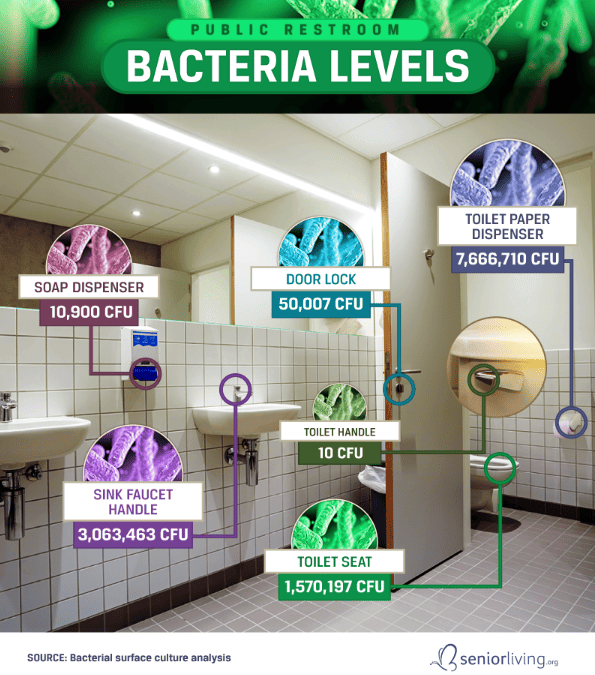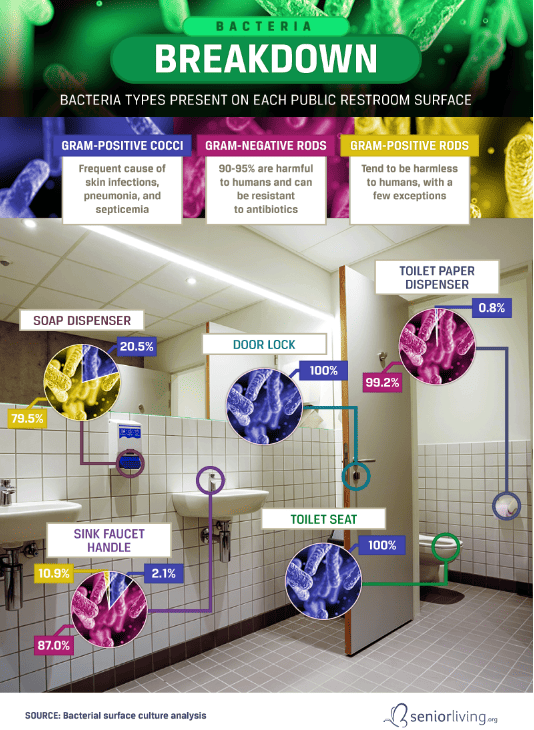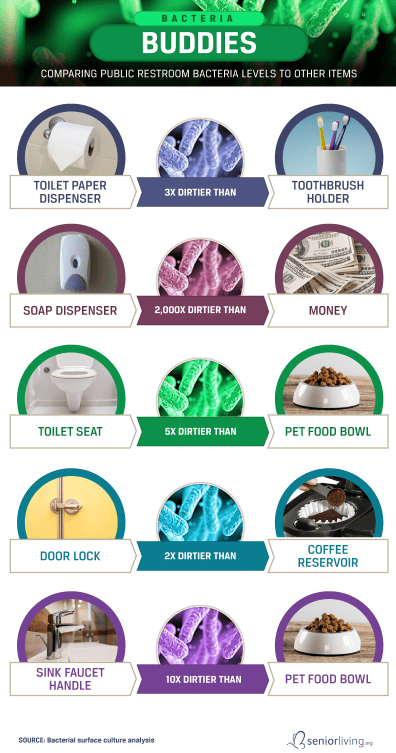Germs in Public Restrooms
Public bathrooms get a bad rap. Graffitied gas station toilets, rows of shopping mall stalls, and fast-food chain washrooms with flickering lights are seen as last-resort options to most. Modern-day outhouses, if you will.
We know what goes on in the privacy of a bathroom, and when you multiply that by dozens of patrons and a full day of use, it’s no wonder some people are genuinely afraid of using these locales. But do they really deserve all that flak? Some experts say public restrooms are very unlikely to pose a threat to a person’s health, but is that enough to absolve them of their second-rate status?
We took to the streets armed with bacterial culture swabs to find out, once and for all, what the germ situation was in the average public bathroom. Are the germs crawling around these spaces harmful to humans, or is the legend of the illness-inducing washroom completely baseless? It was our job to find out.
 If you had five seconds to guess the germiest surface in any given washroom, you would go with the ol’ porcelain throne, right? Understandable, but you would be sorely mistaken. While the toilet seat did indeed turn up a cool 1.5 million CFU (or colony-forming units, which indicate viable bacteria that can reproduce) per square inch, it didn’t hold a candle to the first-place offender.
If you had five seconds to guess the germiest surface in any given washroom, you would go with the ol’ porcelain throne, right? Understandable, but you would be sorely mistaken. While the toilet seat did indeed turn up a cool 1.5 million CFU (or colony-forming units, which indicate viable bacteria that can reproduce) per square inch, it didn’t hold a candle to the first-place offender.
The toilet paper dispenser had over 7.6 million CFU crawling around every square inch of its surface, making it nearly five times dirtier than a public toilet seat. Meanwhile, the sink faucet handle clocked about half the number of CFU, at just over 3 million. Interestingly enough, the toilet handle barely had a trace of germs on its surface.
You’ll likely make contact with these germy washroom touch points before you wash your hands, so don’t forget to lather up to avoid spreading illness and becoming home to millions of germs.

Gram-positive rods are typically harmless to humans save for a few exceptions, and bacillus (which were nowhere to be seen during our swab tests) can either be helpful or harmful to gut health depending on the strain you’re dealing with. In fact, pathogenic gram-positive cocci made up 100 percent of the germ content of both the door lock and toilet seat.
The soap dispenser turned up a majority of gram-positive rods – which, again, are largely benign – accounting for nearly 80 percent of its surface bacteria. Making contact with this item may just be your least risky encounter during your bathroom visit. The number of bacteria on the soap dispenser pales in comparison to the toilet paper dispenser and faucet germ profiles, 99 and 87 percent of which were composed of antibiotic-busting gram-negative rods, respectively.

For starters, you encounter a whole army of germs every time you make a trip to your own kitchen.
Still, public washrooms took the cake in several face-offs. Both the sink faucet handle and the toilet seat had more bacteria than a dog food bowl – and dogs aren’t exactly the poster children for hygiene. And the soap dispenser was a whopping 2,000 times dirtier than money.
The notorious toilet paper dispenser was over three times germier than a toothbrush holder, which sounds impressive enough until you realize that most other items in public washrooms are nowhere near as bacteria-laden as the place you keep your toothbrush. In fact, if you ranked the toothbrush holder among all the washroom items swabbed, it would have stolen third place, knocking the toilet seat down to fourth. Grossed out? Here’s how to clean yours.
Conclusion
If there’s one thing we’ve learned, washing your hands after visiting a public washroom is essentially non-negotiable … just make sure you turn off the faucet with a sleeve pulled over your hand so as not to negate your efforts.
There are ways to avoid making contact with germy surfaces during your next trip to a public restroom, and we suggest keeping an eye out for the toilet paper dispenser and faucet handle, which were crawling with the largest volumes of bacteria – and not the good kind. If you’re worried about inadvertently becoming a human swab as you move about your day, carry a travel-sized hand sanitizer with you for hygiene maintenance purposes.
Methodology
Each surface was swabbed three times at three restaurants or bar public restrooms in the U.S. Colony-forming units (CFU) per square inch were averaged for each surface type. Individual surfaces were chosen based on perceived traffic and accessibility.
Fair Use Statement
Too gross to not share? You’re welcome to share this information online for noncommercial purposes, so long as you link back to this page and our contributors receive proper credit for their work.
